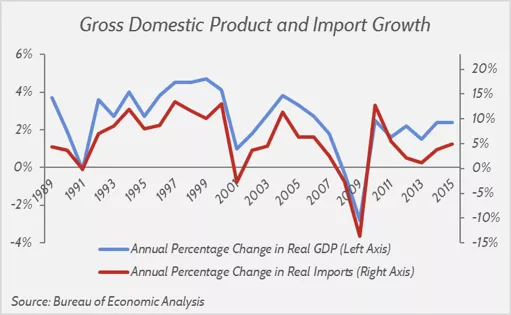- | International Freedom and Trade International Freedom and Trade
- | Expert Commentary Expert Commentary
- |
Christine McDaniel on the US Trade Deficit
On Today's Trade Numbers
The data released this morning show that the trade gap in October exceeded expectations although these data fluctuate from month to month — the drop in exports appears to reflect the effect of recent hurricanes on US agricultural exports. Overall, though, the year-to-date figures show exports and imports are both up from last year, which reflects the growing US demand for goods and services, and the growing foreign demand for US good and services. To me, the steady uptick in demand for US business and financial services exports shows that the Trump trade team should keep pressing for increased market access abroad, especially in areas like digitally enabled trade and services — where both large and small firms would benefit.
Focus on the Total Volume of Trade
Readers should focus on the total volume of trade not the trade balance. Otherwise, you miss the point. Fifty-three percent — over half — of all US imports are actually inputs to domestic businesses.1 When US businesses grow, imports tend to grow (see figure 1). 
The US Trade Deficit Means the US Is a Net Foreign Capital Recipient
In terms of finance, remember, a current account deficit — a trade deficit — generally means we have a capital account surplus. Our net sales of assets is positive, and foreign investors are purchasing more US assets than US investors are purchasing abroad. The US has been a net foreign capital recipient for a long time. This capital surplus stimulates the U.S. economy while boosting our productive capacity.
Imports Are Not a Subtraction from GDP
Imports are not a “subtraction” from GDP. They are merely removed from the final calculation of GDP because they are not a part of domestic production.
On the Trade Deficit
Americans invest more than they save, (gross domestic saving is less than gross domestic investment), and we have a current account deficit and capital account surplus as a result. Trade policy has no real long run effect on a country’s trade balance. If the policy goal is to reduce the trade deficit, then policymakers should focus on ways to increase incentives to save and or reduce incentives to consume.
On Trade Policy
Trade policy has no real long run effect on a country’s trade balance. The Trump trade and economic team should be working to maximize the freedom of Americans to trade goods, services, and assets in the global marketplace.
On Protectionism
By some measures,2 the US imposes the highest number of protectionist measures when you account for trade remedies. Steel tariffs may boost profits for that sector in the near term, but it does nothing to help workers or communities in the long term. And it probably hurts more firms than it helps since so many American businesses rely on competitively priced inputs.
Citations
- Share of US imports of goods by end-use category, 2015, AEI, available at: http://www.aei.org/publication/nearly-all-imports-even-consumer-goods-are-inputs-for-us-firms-and-factories/
- Global Trade Alert, and Credit Suisse, chart shown at: http://www.businessinsider.com/the-us-is-the-most-Christinprotectionist-nation-2015-9